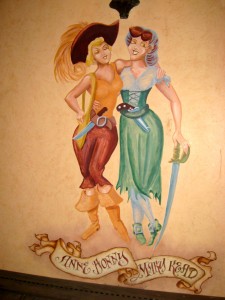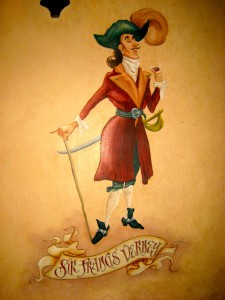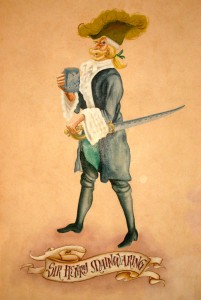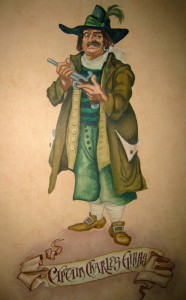The Real Pirates of the Caribbean
As you wait inside the queue for Disneyland’s Pirates of the Caribbean, you surely have noticed the fine drawings on the wall of pirates. What you might not be aware of is that these are the real deal. Well most of them anyway. In doing research for the attraction, Imagineer Marc Davis was inspired by real pirates and their stories. In fact, the attraction was originally going to be a walk through of famous pirates. But the humor started to win out and the walk through became a boat ride and the rest is history. Let’s take a look at the walls and meet the real pirates of the Caribbean.
 Anne Bonny (March 8, 1700-possibly April 25, 1782)
Anne Bonny (March 8, 1700-possibly April 25, 1782)
Just as you enter the door, take a look to the right and tucked away is a painting of two women looking rather happy. One is Anne Bonny and the other is Mary Read. Their fame is due to being the only known women to be convicted of piracy in the Caribbean. What is known about Anne Bonny comes from Captain Charles Johnson’s A General History of the Pyrates. She stabbed a servant girl when she was 13, married a small-time pirate James Bonny, then moved to the Bahamas only to have an affair with another pirate named John “Calico Jack” Rackham. James wants her flogged for adultery but she and Calico Jack escape to become successful pirates. She hooked up with Mary Read and they made a go of it until they were captured in October 1720. She left jail under unknown circumstances and died at the age of eighty-two in 1782.
Mary Read (unknown-1721)
When Mary Read was very young, her mother began to dress her as a boy after the death of her brother in order to continue receiving aide from a Grandmother. Mary continued to dress as a man when she got her first job on a ship. She fell in love and married a Flemish solider and dressed as a woman for the first time. However, he died and she got back into men’s clothes and went back to the sea. After her ship was taken over by pirate Calico Jack and Anne Bonny, she decided to join the crew. It seems Anne Bonny took a liking to Mary only to be surprised that she was a woman. That didn’t matter as the trio terrorized the Caribbean. She was captured in 1720 and sent to prison where she died in 1721.
 Sir Francis Verney (1584-1615)
Sir Francis Verney (1584-1615)
Sir Francis Verney was the product of a famous and powerful British family. Always pictured as the perfect country gentleman by his neighbors they were shocked when he got into an inheritance dispute with his family and decided to make some drastic changes. He left his wife and estate and “turned Turk”. He moved to Morocco and converted to Islam. He plied the Barbary Coast with great success. He was captured and died penniless in Sicily after two years.
Captain Jack Sparrow (Unknown)
Jack is most at home on the sea and was born onboard a ship caught in the middle of a typhoon. He was the son of Captain Teague but rejected the hectic life of being part of a pirate family and snuck away to Tortuga with only the clothes on his back. Always looking for opportunities, he lifted the Sword of Cortes, which gave him the ability to control storms. A very helpful tool if you are a sailor. After much success and many adventures he moved on to his most famous commission, the Black Pearl. He has been described as a blend of Keith Richards of the Rolling Stones and Pepe Le Pew. The final chapters of his life are not well documented. But one thing was certain; he was known to enhance his reputation through fanciful tales.
 Sir Henry Mainwaring (1587-1653)
Sir Henry Mainwaring (1587-1653)
While many pirates were products of poverty, Sir Maiwaring was born to an elite class. His family was contemporaries of William the Conqueror and his Grandfather was the Vice-Admiral of Sussex. He graduated from Oxford University at the age of 15 with a law degree. His sailing career began with a commission to hunt down a famous pirate. But he turned his weapons on anything Spanish. He was so dominant, the Spanish government decided to hire him and his fleet in exchange for a full pardon. Britain also granted him a full pardon and he went on to write a Discourse of Pirates in 1618. He was knighted in 1618 and became a Vice-Admiral. Not your typical pirate.
Captain Hector Barbossa
Known as the Pirate Lord of the Caspian Sea, Hector Barbossa was born from unknown origins and extreme poverty. He went to sea at the age of 13. He led a successful career and ended up on the crew of the Black Pearl rising to the rank of First Mate. The stories of that time are legendary and would make for a good movie. He traveled all over the world including Singapore. Throughout his journeys the East India Trading Company pursued him. Another merciless pirate, his reputation for brutality was legendary as was his morbid sense of humor. At one point Tia Dalma also known as Calypso also resurrected him from the dead. He returned the favor by helping to release Calypso from her human bonds. From this point his story gets murky but research into his life continues with further tales sure to be told.
 Charles Gibbs (November 5, 1798 – April 22, 1831)
Charles Gibbs (November 5, 1798 – April 22, 1831)
Charles Gibbs real name was James D. Jeffers and was born in Newport, Rhode Island. He would be one of the last active pirates in the Caribbean and one of the last executed. He claims to have slaughter as many as 400 victims and his legend grew after his death. Born to a sea captain, Gibbs started his career in the United States Navy. His claim to fame was his brutality towards prisoners including chopping off their arms and legs or burning entire crews alive. He was captured in Long Island and executed on Ellis Island in 1831.
Edward “Ned” Low (1690 – 1724)
Ever since Ned low was young he was always in trouble. He was a pickpocket and burglar. After his wife died in childbirth, Ned Low set out to sea to become a pirate. He was a very successful pirate who captured at least a hundred ships in his brief three-year career. He had a nasty reputation and was known to torture his victims before killing them including burning a French cook alive (“greasy fellow who would fry well”) and the slaughter of 53 Spanish captives. Intimidation was his calling card. He was inevitability hanged in Martinique in 1724.
For more from Sam, buy his book Walt and the Promise of Progress City.





I really enjoyed this. Great stuff!
Barbossa’s stories “… are legendary and would make for a good movie.” Yeah, I see what you did there.